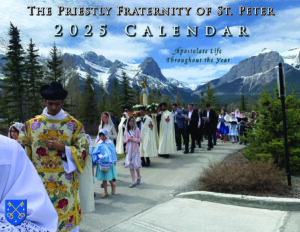The Home Altar through the Liturgical Year
Locked out of our churches for so many weeks this year, and being compelled to either offer prayers on our own, read our Missals, or follow along with televised Masses, we have all gained a new appreciation for bringing the liturgy into our homes.
The concept of the “domestic Church” has a very ancient pedigree. In his letter Of the Good of Widowhood, St. Augustine asked to be included in the prayers of the holy woman Juliana cum tota domestica vestra Ecclesia: “with all your household Church.” St. John Chrysostom called the home a micra ecclesia, a little church, and St. Clement of Alexandria called marriage a microbasileia, a little kingdom.
While naturally we can’t offer Mass or other rites as our priests and bishops do in sacred buildings, we are all still very much expected to unite ourselves with those rites in spirit, even to the extent of making our homes a spiritual and even physical extension of our parishes into the secular world.
Thus, many of us have already created a little prayer corner in our homes where we can say the Rosary, offer morning or night prayers, and light a candle once in a while.
And many households also, especially those with children, take great delight in characteristic seasonal devotions, such as constructing a Nativity scene, chalking the lintels at Epiphany, and setting up an Easter candle or garden.
Unfortunately, these seasonal devotions by their very nature tend to come and go, leaving large sections of the year with few obvious customs to replace them.
We are very soon to enter the long period of the Sundays after Pentecost—half a year of “ordinary” green Sundays. How can we keep ourselves and our children as engaged as we seem to be on the 1st Sunday of Advent?
Here is where a home altar can come in.
By maintaining a home altar not just as a static home for our rosaries and prayer books but as a closer mimic of its ecclesial namesake, the liturgical year can be a visible part of your home at all times.
There are many possible methods to do this, but here is one framework.
First, an altar cloth of the appropriate liturgical color can be used. A fabric store will be happy to cut bolts of inexpensive colored cloth to your specifications, and these can then be hemmed and decorated with embroidery or appliqué. (Or, if you are not so skilled in the domestic arts, a wide strip of white lace is an attractive complement.) The altar cloth is changed at the beginning of each new liturgical season and, if desired, at important feast days such as the Assumption.
Next, statues and icons of favorite family saints are placed atop the altar. Some may stay there year round—favorite images of Our Lord and Our Lady for example—but the others can be rotated in at the beginning of each month, depending on the sanctoral calendar. So on March 1st, St. Thomas Aquinas, St. Gregory the Great, St. Patrick, St. Joseph, and the Annunciation appear on the altar, to be replaced on April 1st by St. George, St. Mark, St. Catherine of Siena, and St. Kateri (in Canada). And as each saint’s feast day arrives, the appropriate image can be moved to the center of the altar and a votive candle set before it.
Natural decorations such as flowers and greenery can be changed at the Ember Days or Quartertides. Advent is a wonderful time for evergreens and wreaths. At the Lenten Embertide, we content ourselves with dry sticks and thorns, then palms or pussy willows during Holy Week, until Easter morning when the altar joyously breaks forth in flowers. After the Ember Days of Pentecost, the flowers can be continued along with typical summertime greenery, until the Ember Days of September, when autumnal displays and harvest decorations close out the liturgical year.
Other pious practices, borrowed from our parishes, quickly suggest themselves. Some extra violet cloth will allow you to cover the sacred images at Passiontide. The home altar can be stripped on Maundy Thursday and, save for any Good Friday devotions, left bare until Easter. At All Saints’ Day, the altar can be filled to capacity with every icon and statue available. During All Souls’ Day, black cloth and family photos can remind us to pray for the Church Suffering.
Candles are an excellent addition when the children are old enough. If tapered ones are too expensive, tea lights can be used. Moreover, colored candles or votive holders can bring in secondary hues based on the season or feast. For example, a plain white altar cloth can be complemented with red and green candles for Christmas, gold or yellow for Easter, and blue for feasts of Our Lady.
Since it is a well-established liturgical principle that the Roman calendar changes according to local interest and patronage, consider how this idea can be applied to your own “little church.” Do you have special family patrons? Honor them in a special way with an octave—a week-long celebration on the family altar. Octaves used to be quite plentiful in the Roman Rite, and it is a very natural sentiment to want to extend major feasts for a week-long celebration. You can also specially celebrate family name days, baptismal and wedding anniversaries, and even those servants of God and Venerables whom you are devoted to but are not yet permitted to have a public cultus; and of course it is also a good thing to remember your loved ones on the days of their death.
Overall, maintaining a home altar provides us with a tangible and visible connection to our parishes, and it extends liturgical living well beyond the hour and a half on Sunday when we are present at Mass. We can even accompany our altar decorations with appropriate seasonal prayers—the Commemorations mentioned in our Monday article are very well suited for this purpose.
The home altar is a particularly powerful teaching tool for young children. They may not yet have the understanding or the attention span to pick up on subtle changes in recited prayers—but they are naturally fascinated by colors, images, flowers and lights and will participate with enthusiasm. (They can even be encouraged to keep “side altars” in their own rooms with colored cloths, toy saints, and their favorite medals and rosaries.)
As we finally start to emerge from our various states of lockdown, may it please God that we never have to endure such a long disruption of our parish liturgical life again.
But it was not time wasted if, having accepted the deprivation prayerfully and penitentially, we now appreciate the sacred liturgy much more keenly than we ever have before, and bring it to the very center of our homes and our hearts.
June 10, 2020









